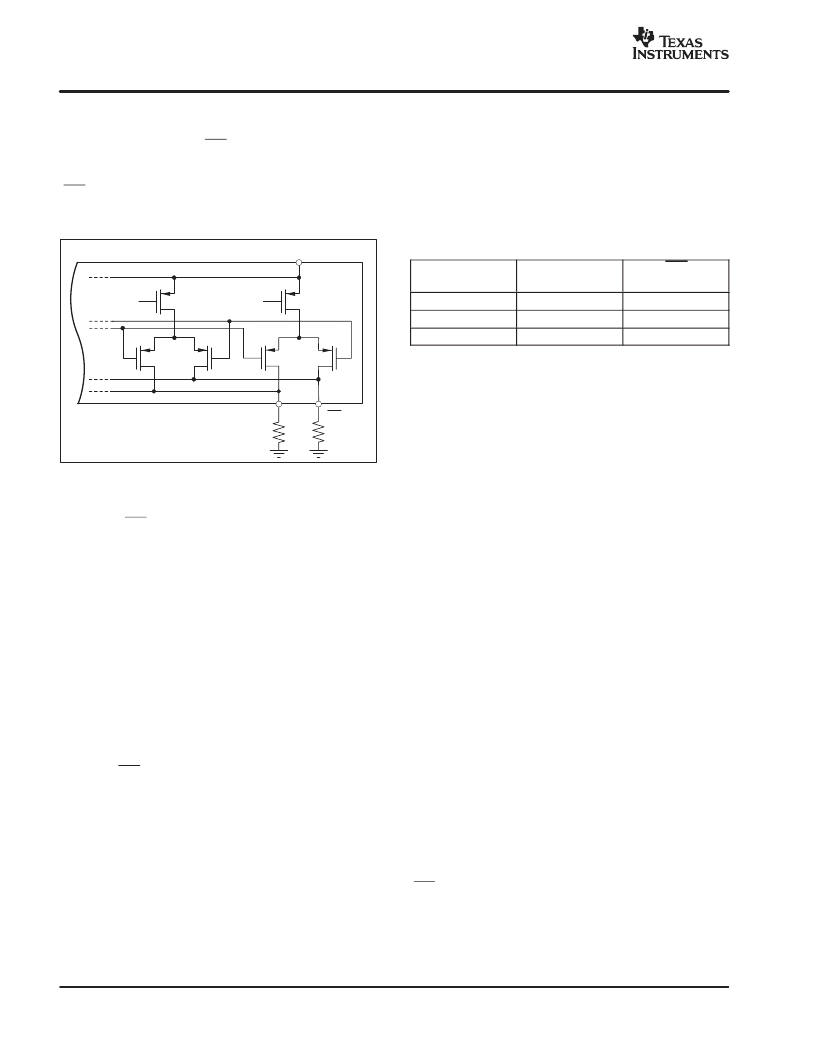- 您現(xiàn)在的位置:買賣IC網(wǎng) > PDF目錄376557 > DAC2932 DUAL 12-BIT 40MSPS DIGITAL TO ANALOG CONVERTER PDF資料下載
參數(shù)資料
| 型號(hào): | DAC2932 |
| 元件分類: | DAC |
| 英文描述: | DUAL 12-BIT 40MSPS DIGITAL TO ANALOG CONVERTER |
| 中文描述: | 雙通道12位40MSPS數(shù)模轉(zhuǎn)換器 |
| 文件頁數(shù): | 16/24頁 |
| 文件大小: | 343K |
| 代理商: | DAC2932 |

SBAS279C AUGUST 2003 REVISED OCTOBER 2004
www.ti.com
16
ANALOG OUTPUTS
The DAC2932 provides two sets of complementary
current outputs, I
OUT
and I
OUT
. The simplified circuit of the
analog output stage representing the differential topology
is shown in Figure 28. The output impedance of I
OUT
and
I
OUT
results from the parallel combination of the differential
switches, along with the current sources and associated
parasitic capacitances.
I
OUT
I
OUT
DAC2932
R
L
R
L
+V
A
Figure 28. Equivalent Analog Output
The signal voltage swing that develops at the two outputs,
I
OUT
and I
OUT
, is limited by a negative and positive
compliance. The negative limit of –0.5V is given by the
breakdown voltage of the CMOS process, and exceeding
it will compromise the reliability of the DAC2932, or even
cause permanent damage. With the full-scale output set to
2mA, the positive compliance equals 0.8V, operating with
an analog supply of +V
A
= 3V. To avoid degradation of the
distortion performance and integral linearity, care must be
taken so that the configuration of the DAC2932 does not
exceed the compliance range.
Best distortion performance is typically achieved with the
maximum full-scale output signal limited to approximately
0.5V
PP
. This is the case for a 250
load and a 2mA
full-scale output current. A variety of loads can be adapted
to the output of the DAC2932 by selecting a suitable
transformer while maintaining optimum voltage levels at
I
OUT
and I
OUT
. Furthermore, using the differential output
configuration in combination with a transformer is
instrumental
in
achieving
performance. Common-mode errors, such as even-order
harmonics or noise, can be substantially reduced. This is
particularly the case with high output frequencies.
For those applications requiring the optimum distortion
and noise performance, it is recommended to select a
full-scale output of 2mA. A lower full-scale range down to
excellent
distortion
0.5mA may be considered for applications that require low
power consumption, but can tolerate a slightly reduced
performance level.
The current-output DACs of the DAC2932 have a straight
offset binary coding format. With all bits high, the full-scale
output current (for example, 2mA) will be sourced at pins
I
OUT1
and I
OUT2
, as shown in Table 2.
Table 2. Input Coding vs Analog Output Current
INPUT CODE
(D11D0)
IOUT
(mA)
IOUT
(mA)
1111 1111 1111
2
0
1000 0000 0000
1
1
0000 0000 0000
0
2
OUTPUT CONFIGURATIONS
As mentioned previously, utilizing the differential outputs
of the converter yields the best dynamic performance.
Such a differential output circuit may consist of an RF
transformer or a differential amplifier configuration. The
transformer configuration is ideal for most applications
with ac coupling, while op amps are suitable for a
dc-coupled configuration.
The single-ended configuration may be considered for ap-
plications requiring a unipolar output voltage. Connecting a
resistor from either one of the outputs to ground converts the
output current into a ground-referenced voltage signal. To im-
prove on the dc linearity by maintaining a virtual ground, an
I-to-V or op-amp configuration may be considered.
DIFFERENTIAL WITH TRANSFORMER
Using an RF transformer provides a convenient way of
converting the differential output signal into a single-ended
signal while achieving excellent dynamic performance
(see Figure 3). The appropriate transformer should be
carefully selected based on the output frequency spectrum
and impedance requirements. The differential transformer
configuration has the benefit of significantly reducing
common-mode signals, thus improving the dynamic
performance over a wide range of frequencies.
Furthermore, by selecting a suitable impedance ratio
(winding ratio), the transformer can be used to provide
optimum impedance matching while controlling the
compliance voltage for the converter outputs. The model
shown, ADT16-6T (by Mini-Circuits), has a 4:1 ratio and
may be used to interface the DAC2932 to a 50
load. This
results in a 400
load for each of the outputs, I
OUT
and
I
. The output signals are ac coupled and inherently
isolated by the transformer.
相關(guān)PDF資料 |
PDF描述 |
|---|---|
| DAC2932PFBR | DUAL 12-BIT 40MSPS DIGITAL TO ANALOG CONVERTER |
| DAC2932PFBT | DUAL 12-BIT 40MSPS DIGITAL TO ANALOG CONVERTER |
| DAC312BR | 12-Bit Digital-to-Analog Converter |
| DAC312GBC | 12-Bit Digital-to-Analog Converter |
| DAC312FR | 12-Bit High Speed Multiplying D/A Converter |
相關(guān)代理商/技術(shù)參數(shù) |
參數(shù)描述 |
|---|---|
| DAC2932EVM | 功能描述:數(shù)據(jù)轉(zhuǎn)換 IC 開發(fā)工具 DAC2932 Eval Mod RoHS:否 制造商:Texas Instruments 產(chǎn)品:Demonstration Kits 類型:ADC 工具用于評(píng)估:ADS130E08 接口類型:SPI 工作電源電壓:- 6 V to + 6 V |
| DAC2932PFBR | 功能描述:數(shù)模轉(zhuǎn)換器- DAC Dual 12-Bit 40MSPS RoHS:否 制造商:Texas Instruments 轉(zhuǎn)換器數(shù)量:1 DAC 輸出端數(shù)量:1 轉(zhuǎn)換速率:2 MSPs 分辨率:16 bit 接口類型:QSPI, SPI, Serial (3-Wire, Microwire) 穩(wěn)定時(shí)間:1 us 最大工作溫度:+ 85 C 安裝風(fēng)格:SMD/SMT 封裝 / 箱體:SOIC-14 封裝:Tube |
| DAC2932PFBRG4 | 功能描述:數(shù)模轉(zhuǎn)換器- DAC Dual 12-Bit 40MSPS RoHS:否 制造商:Texas Instruments 轉(zhuǎn)換器數(shù)量:1 DAC 輸出端數(shù)量:1 轉(zhuǎn)換速率:2 MSPs 分辨率:16 bit 接口類型:QSPI, SPI, Serial (3-Wire, Microwire) 穩(wěn)定時(shí)間:1 us 最大工作溫度:+ 85 C 安裝風(fēng)格:SMD/SMT 封裝 / 箱體:SOIC-14 封裝:Tube |
| DAC2932PFBT | 功能描述:數(shù)模轉(zhuǎn)換器- DAC Dual 12-Bit 40MSPS RoHS:否 制造商:Texas Instruments 轉(zhuǎn)換器數(shù)量:1 DAC 輸出端數(shù)量:1 轉(zhuǎn)換速率:2 MSPs 分辨率:16 bit 接口類型:QSPI, SPI, Serial (3-Wire, Microwire) 穩(wěn)定時(shí)間:1 us 最大工作溫度:+ 85 C 安裝風(fēng)格:SMD/SMT 封裝 / 箱體:SOIC-14 封裝:Tube |
| DAC2932PFBTG4 | 功能描述:數(shù)模轉(zhuǎn)換器- DAC Dual 12-Bit 40MSPS RoHS:否 制造商:Texas Instruments 轉(zhuǎn)換器數(shù)量:1 DAC 輸出端數(shù)量:1 轉(zhuǎn)換速率:2 MSPs 分辨率:16 bit 接口類型:QSPI, SPI, Serial (3-Wire, Microwire) 穩(wěn)定時(shí)間:1 us 最大工作溫度:+ 85 C 安裝風(fēng)格:SMD/SMT 封裝 / 箱體:SOIC-14 封裝:Tube |
發(fā)布緊急采購,3分鐘左右您將得到回復(fù)。